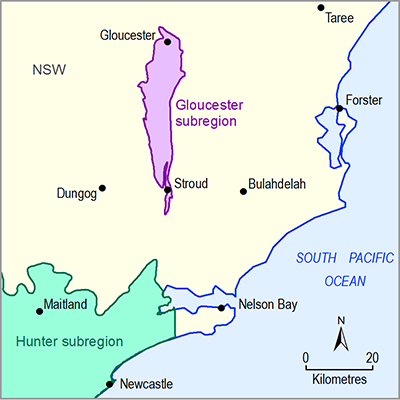- Home
- Assessments
- Bioregional Assessment Program
- Gloucester subregion
- 2.1-2.2 Data analysis for the Gloucester subregion
- 2.1.3 Hydrogeology and groundwater quality
- 2.1.3.2 Statistical analysis and interpolation
This section describes the methods for assigning bores to aquifers.
Information on screening depths and stratigraphy is needed to assign bores to specific aquifers. The NSW groundwater database contains no stratigraphic data for groundwater bores in the Gloucester subregion. Following a stratigraphic assessment for the Gloucester subregion in NSW, and after a quality check of the data from the NSW groundwater database, bores were assigned to aquifers by comparing their screen intervals and depth with aquifer boundary data.
The following steps were followed during the aquifer assignment:
- Assess the boundaries of aquifers as outlined in Section 1.1.4.1.1 of the companion product 1.1 for the Gloucester subregion (McVicar et al., 2014).
- Determine the screen intervals of bores. The screen information was extracted from the ‘Construction and Borehole’ tables in the National Groundwater Information System (NGIS) V2 groundwater data archive. The keywords ‘OPENING’ and ‘HOLE’ were used to obtain the data for calculating screen intervals. The bore depth information was extracted from the NSW Water Data Transfer Format (WDTF), Hydstra, and the NGIS V2 dataset. For bores without depth information in these databases, the bore depth calculations were based on the construction information.
- Determine the screen interval of bores for the NSW bores.
- Filter bores for a specific area using a shape file or coordinates.
- Cross-check the final datasets against expert knowledge and spatial context of aquifers.
Table 12 summarises the number of bores per aquifer that were extracted from the available datasets and aquifer depth ranges. Bores for which screening depth information was not available have been assigned to an aquifer based on drilled depth as per the aquifer depth ranges in Table 12. Figure 14 shows the distribution of bores and depth class within the Gloucester subregion.
The alluvium and fractured rock aquifer subgroups represent the most extracted aquifer with 107 and 53 associated bores, respectively. There are 55 bores with bore depths less than 1 mBGL; it is likely that these bores were started but not fully completed and hence are not used to currently extract groundwater. The mean of bore depths is about 89 m. Most bores are either screened to the alluvium or the outcrops of underlying bedrock aquifers. Further information about the analysis of distribution of bores and estimated groundwater usage by purpose in the Gloucester subregion is available in Section 1.5.1.2.1 of companion product 1.5 for the Gloucester subregion (Rachakonda et al., 2015).
Table 12 Number of bores with construction information according to aquifer for the Gloucester subregion
|
Groundwater-bearing unit |
Number of bores |
Depth rangea (mBGL) |
|---|---|---|
|
Alluvium |
107 |
< 15 |
|
Fractured Rock |
53 |
15 to 150 |
|
Deep water-bearing |
15 |
>150 |
aThe depth column presents the depth range of bores associated with a specific aquifer.
Data: Bioregional Assessment Programme (Dataset 7)

Product Finalisation date
- 2.1.1 Geography
- 2.1.2 Geology
- 2.1.3 Hydrogeology and groundwater quality
- 2.1.4 Surface water hydrology and water quality
- 2.1.5 Surface water – groundwater interactions
- 2.1.6 Water management for coal resource developments
- Citation
- Acknowledgements
- Currency of scientific results
- Contributors to the Technical Programme
- About this technical product
